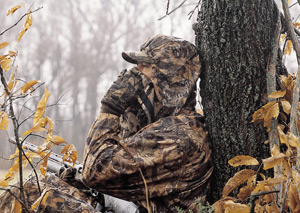Hunter Education - Tree Stand Safety Tips
Main_Content
Tree Stand Safety Tips
One of the most popular pieces of equipment used by deer hunters is a tree stand. Tree stands can be dangerous if they are used incorrectly or carelessly. Nationally, one in three hunting injuries involves a tree stand. Falls from tree stands can be caused by a variety of factors, including a weakness in the stand's structure and incorrect installation. Hunters also may fall asleep while on their stands. Tree stands can also be a factor in other hunting accidents, including injury from accidental firing of a loaded firearm while the hunter is climbing to the stand. To help prevent these accidents, follow these safety precautions:

- Never carry equipment with you while climbing. Use a haul line to raise or lower your gear. Make sure guns are unloaded and broadheads are covered prior to raising or lowering firearms or bows with a haul line.
- Since most climbing accidents occur when hunters are
climbing up or down, always use a full-body safety harness when hunting
from elevated stands. Review manufacturers recommendations before using
any equipment. Never use a rope to replace a safety harness.
- Read, understand and follow the factory recommended practices and procedures when installing commercial stands. Inspect portable stands for loose nuts and bolts each time they are used.
- Choose only healthy, living trees when using climbing devices. Rough-barked trees such as oak are best. Do not use a tree that is rotten or has dead limbs.
- Never put your weight on a single branch. Keep at least one hand and one foot on a secure place when reaching for the next hold.
- Climb higher than the stand and step down onto it. Climbing up onto it can dislodge it.
- Wear boots with non-skid soles, because steps or platforms can be slippery in rain, sleet or snow.
- When climbing, always maintain three points of contact.
- Tell a dependable person where you're hunting and when you plan on returning. Map your whereabouts and leave a note at camp, at home or in your car so that you can be found.
- Don't fall asleep. This is a common cause of accidents. If you get drowsy, move your arms rapidly until you feel alert.
- Never wear a ring in any climbing situation. Rings can catch on tree limbs and equipment.
- As a precautionary measure, remove all logs, upturned and cutoff saplings, rocks and other obstructions on the ground below the tree stand.
- Use updated equipment. When used properly, newer tree stand equipment is solid, safe and secure. Older models of safety belts offer some protection, but newer safety harnesses offer more protection.
- Carry a whistle to call for help and carry a first aid kit, flashlight and cellular telephone in a fanny pack.
